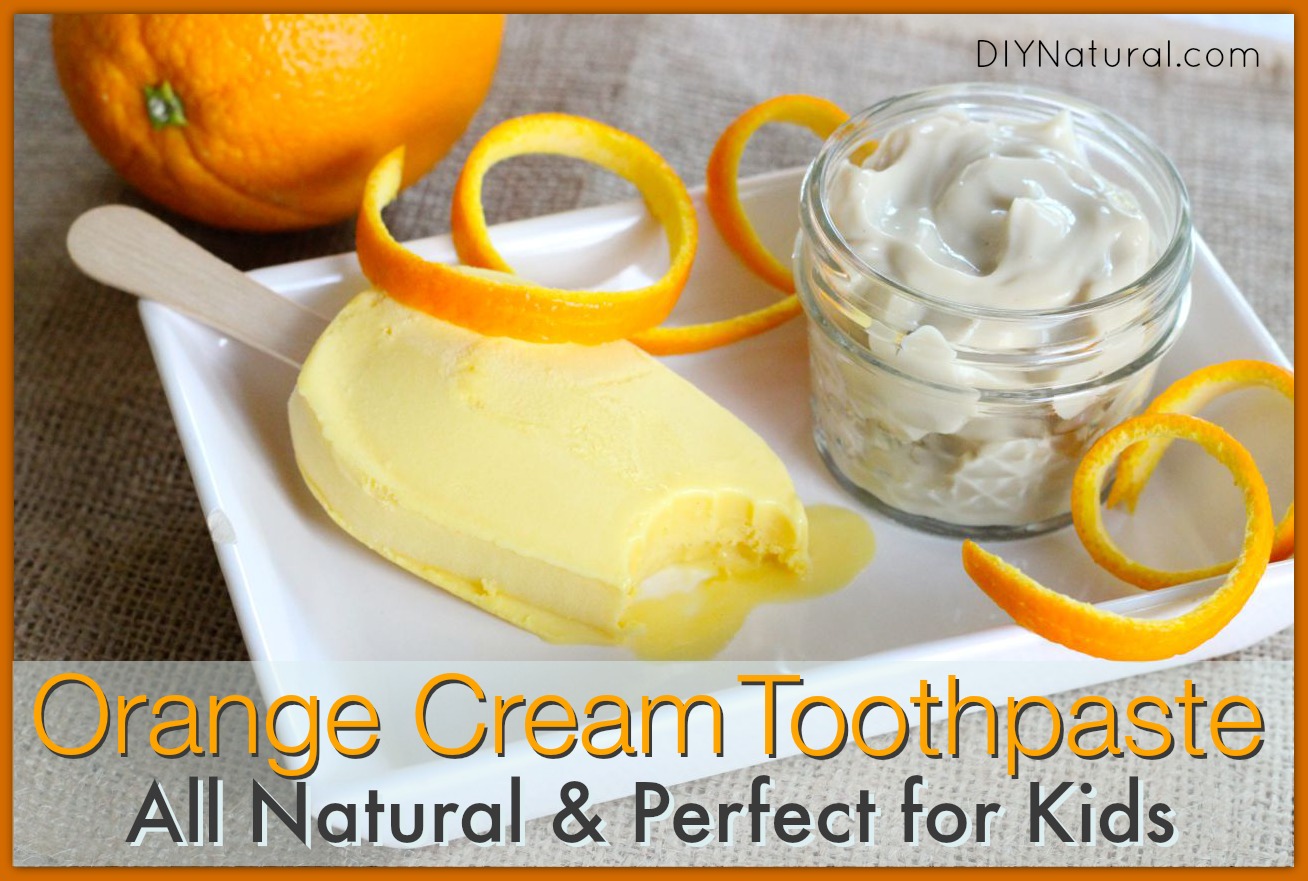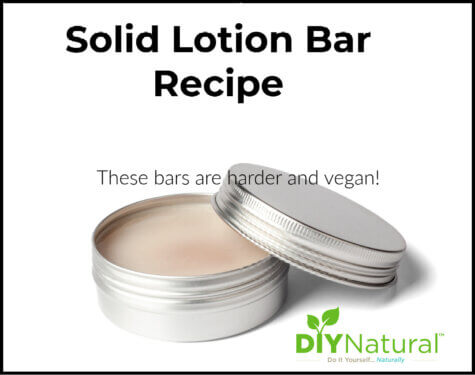
If you’re into making natural personal products, chances are you’ve had to convince some family members to try things they weren’t crazy about. My sister-in-law recently made our tooth powder recipe and informed me that our nephew was all but disgusted with the flavor and texture of the product. I took this as a challenge.
Last year I started making my own version of Earthpaste (a great commercial brand of natural toothpaste). Their paste only contains a few ingredients – all of which I normally keep around – so concocting my own was simple. In the past, I had only used peppermint and vanilla to flavor my batches. I loved it, but started looking at my essential oil collection for a more kid-friendly flavor combination.
I finally came up with… sweet orange + vanilla = orange cream (just like a Creamsicle®)! Perfect for kids, with its sweet fruity flavor and the creamy texture of the clay-based paste. You’ll want to make a batch for yourself, because it’s perfect for adults as well!
What to expect with this homemade toothpaste
The best part of this DIY paste is that you’re NOT going to get fluoride, sodium lauryl sulfate, artificial colors, artificial flavors, or any of the other chemicals and additives that are added to commercial toothpaste.
Instead, you’re getting only natural ingredients that are beneficial for oral health. Bentonite clay is one of the most important ingredients in this paste, creating a nice smooth consistency and giving your teeth things they need. Bentonite clay is high in several minerals that are good for teeth, like silica, calcium, and magnesium. It also has the ability to bind to and absorb toxins in the mouth.
Even though it’s more kid-friendly, this DIY paste still might take a little getting used to. It doesn’t contain foaming agents like commercial pastes, so you won’t have bubbles when brushing with this. Tell your kids this is a good thing! It also has an off-white color due to the clay – not the bright white (or blue or red) your family might be accustomed to.

Orange Creamsicle Toothpaste Recipe
Ingredients
- ¼ cup bentonite clay powder (find it here)
- 2 teaspoons non-GMO xylitol (find it here)
- ¼ teaspoon unrefined sea salt (we use this)
- ½ cup filtered water (we use and love these filtration systems)
- 10 drops sweet orange essential oil (find 100% pure sweet orange EO here)
- 5 drops vanilla essential oil (find 100% pure vanilla EO here)
Directions
- In a glass or wooden bowl combine bentonite clay, xylitol, and sea salt. Note: Bentonite clay loses some of its beneficial properties when it comes into contact with metal, so always choose non-metal bowls and utensils when mixing this toothpaste.
- Pour ½ cup water over dry ingredients and mix with a plastic, rubber, or wooden utensil until it forms a smooth paste. Add essential oils and mix well.
- Transfer to a small glass jar or squeeze tube with a tight-fitting lid. Label well.
To Use
If storing in a jar, simply dip a toothbrush into the toothpaste and brush as normal. You may want to provide each family member with his/her own jar so germs aren’t shared. These squeeze tubes are easy to fill if you prefer having a tube of toothpaste.
Note: Be sure kids do not swallow large amounts of this toothpaste since it contains essential oils.
Variations
If orange cream isn’t your thing, feel free to experiment with other flavors. Try peppermint, spearmint, cinnamon, or vanilla mint. (In some cases, less of these essential oils should be used since they can be strong.)
*******




Thanks guys I am now going to try the tooth paste. will come back and let you know how it worked for my family. Usually all your products are tops for me but I do have some very particular folks to deal with at home so will be back with a report. Many thanks again!
Ha! We understand the part about having “particular” people to deal with. 🙂 If your family doesn’t like it the first time, take notes and adjust the recipe. (You can take out the salt if they think it’s salty, add a little more oils if the flavor isn’t just right, etc.) Hope you can please everyone on the first try with this one! 😉
SCORE!!!!!! I found a small amount of whitish BC at the local health food store so figured I’d buy and make this the exact way you did. I even broke down and bought xylitol (usually I avoid all sweeteners but raw honey). You’d said I could have used my greenish clay but figured for $4 why not make it exact 🙂 Score! This is by far my new favorite DIY toothpaste. I’ve tried several and do like the powder one best, UNTIL NOW!!! I think I’m also gonna go ahead and use the green BC and make a traditional mint or maybe a sage and clove one.
Only thing I did add to this recipe was a few trace mineral drops I’ve been re mineralizing my teeth since switching to all natural and DIY and figured it’s water based so why not add it to this.
Thanks bunches you guys have truly outdone yourselves w/ this recipe.
~Angie
Fabulous!!! I’m so glad you like this one Angie! It’s definitely my fave out of all the DIY toothpastes we’ve made. 🙂
Has anyone used powdered bone meal (NOW food grade) in your toothpaste recipe? It sounds to me like it might be a good remineralizing ingredient.
I try to make my toothpaste palatable enough that I don’t have to spit it out. I use ingredients that I believe add to my health (but may not be best for drain pipes or septic tanks). I think my stomach acids can handle any bacteria that form on my teeth and are being brushed off.
Any thoughts on any of the above comments/questions?
Thanks.
Okay I need to get clarification and your opinion. I keep coming back to this recipe and wonder. I have this product of bentonnite clay http://www.iherb.com/Now-Foods-Bentonite-Powder-100-Pure-Clay-1-lb-454-g/15252?at=0 I’d sure it’s real yet it’s greenish. If I use this there is no way my finished product will look creamy like yours. Is it your opinion this isn’t the same clay, or is it just a color difference and no big deal. Thanks for any input
Yes, that’s bentonite! Go ahead and use it and don’t worry about the color. Clays are a natural substance so there’s bound to be some color variations even within the same clay family. If you don’t feel right about having a greenish toothpaste with an orange flavor, maybe you’ll like vanilla mint better! 🙂
Oh great I hope it comes out well I’ll come back and letcha know for sure. I usually use a mint and clove flavor so maybe since it’s greenish that’d make more sense but maybe I tiny trial for the hubby w/ orange, he got all excited seeing this post 🙂
We have a septic system, and I’ve read that Bentonite Clay not recommended for one. With 5 people brushing multiple times a day it would eventually add up. We should probably sub baking soda. Any thoughts?
Also, could Vegetable Glycerin (USP food grade) be used in place of Xylitol? I believe they’re both used in natural toothpastes and are good for teeth.
I haven’t researched bentonite clay’s effects on septic systems, but the bentonite clay is very diluted once it’s spit out of your mouth. If you want to sub baking soda though, you’ll want to check out our other recipe and add the orange/vanilla oils if you want the orange cream flavor: https://www.diynatural.com/homemade-toothpaste/
We don’t recommend glycerin in toothpaste. It actually coats the teeth, preventing remineralization. It takes about 20-30 brushings to completely remove the glycerin left on your teeth from one brushing. It’s one of the ingredients natural toothpaste companies continue to put in their pastes (for extra “slip”) that we are trying to stay away from. Hope that helps Kim!
First of all, thank you for replying so quickly! Although the clay recipe looks creamy, we’ll try the simple baking soda recipe first. I did see another paste recipe (which I can’t find now of course) that included organic coconut oil. That is another product we use in our home already, and it might make it creamy and easier to swipe/squeeze onto the brush for the kiddos. Any problems with coconut oil on teeth that you’re aware of?
I’ll add xylitol for sweetener. I’m surprised about the vegetable glycerin since it’s water soluble. Thought I’d save myself from more ingredients since we already use food grade glycerin for skin and making bubbles. No worries though.
Thank you for the information and links!
Coconut oil is wonderful for teeth, and we occasionally add it to our baking soda toothpaste recipe. You will want to run a little hot water down the drain after spitting though, because the coconut oil will harden in a cold drain. Depending on the temps in your bathroom, the coconut oil toothpaste will be quite hard in the winter and very soft & workable in the warmer months. Have fun making this!
Sounds great! Looking forward to giving it a try after my supplies arrive. Thank you for your advice!
Thanks for this recipe! Was just wondering: I’ve heard how good black walnut hulls and white oak bark are for teeth and gums, so was wondering if it’d be ok to add these, in powder form , to the toothpaste? I didn’t now if it’d be ok to mix these with the clay or not??
We haven’t experimented with or researched either of those things for oral health, so we can’t give any input there. Sounds like a good experiment though! 🙂
I ordered bentonite clay in the netherlands, but my toothpaste is green and it has a real clay flavour. It does not look like a creamy nice paste…is it still oké to use ?
Hi there,
It sounds like you may have ended up with French Green clay, but you’ll want to check with the source where you purchased it. I have not heard of this type of clay being used in oral preparations, so you’ll want to do a little further research before using that batch you’ve already made. 🙁
Can you use extract instead of oils?
If no, what’s the difference?
You could use extracts, but the amounts won’t be the same and you won’t get any of the therapeutic benefits of essential oils. (Some oils are antiseptic, antibacterial, etc.)
I have 2 out of 4 kids’ (6 & 3) that do not like regular toothpaste so they use Tom’s Strawberry. So when i saw this, I was so excited!!! New flavors! I just started making lip balms so I have a nice assortment of essential oils.
My only fear is not knowing how much EO to add for different flavors and in return ruining the batch. Do you have any suggestions? I’m curious too on your amounts of EO on your vanilla mint. That sounds wonderful! 🙂
Hi Jen,
The trick is to just add a little of your essential oils at a time, taste in between additions, and keep adding until you like the flavor. You’ll never need more than 15-20 drops of EO in one batch, so just start with a few and go from there. For my vanilla mint batch I used 12 drops of peppermint and 4 drops of vanilla.
Hope your kids love this recipe!
How much does this make? Just the 4oz? I’d like to make one for each of us here at home (4 of us) so I’m trying to figure out how much to buy. Thank you.
Yes, this recipe makes just under 4 ounces.
My dentist recommeneds a baking soda toothpaste to counteract the acid in most foods and the breakdown of foods into acid. Could you add baking soda to this..or would you need to? Also, my husband has extremely sensitive teeth, and so he uses and Arm & Hammer with Orajel for sensitivity. Is there anything that would help with his sensitivity in this recipe? Thanks!
Hi Laurinda,
You could add baking soda to this recipe if you like, but you won’t need to. Bentonite clay has a high pH (similar to that of baking soda), so it will do the same thing. I haven’t studied out ingredients for sensitive teeth, so I can’t say for sure if there’s anything in this recipe that will help with your husband’s sensitivity.
Hello, I’ve heard many discouraging things about using bentonite clay, such as:
– It’s not approved for ingestion or oral health
– There is some content of lead in it
– It can cause drying of tissues
I’ve read a lot of varied information, but I seem to get more confussed each time. Could someone help me clear my doubts?
Hi Haydee, do you have any reliable sources for this that we could see? Thanks and blessings.
No Matt, I’m sorry, non that is realiable. This is why I was so confussed.
Betsy has cleared a lot for me. Still, I’m going to dig a little bit on lead.
Thanks both!
Haydee,
There are certain companies that do not have a license to market their bentonite clay for internal use, so you may see warnings on some bentonite clays that say “not for internal use,” or something else similar. However, there are many companies that can and do market it for ingestion, and have hoards of people singing the praises of bentonite clay for health.
You are correct, there is a very small amount of lead in most bentonite clays, and the Redmond company addresses it here: http://www.redmondtrading.com/prop65/
Everyone’s body reacts differently to everything. So I’m sure there are folks out there who have experienced drying from using bentonite clay (although I have not heard of this).
Hope that helps!
If you wanted it to be orange colored a little turmeric should do the trick.
Guy
I love it! Great suggestion Guy!
I love orange essential oil, but wouldn’t it be acidic and possibly erode tooth enamel? Maybe the clay would neutralize it?
Thanks for any response.
That’s a really great question, Priscilla. Actually I just tested the pH of my orange EO and found it to be around 6..not as low (acidic) as orange juice itself. And the pH of bentonite clay is pretty high (non-acidic) – roughly 9 or so. I just tested my batch of toothpaste with some pH strips, and found that the pH is around 7.5, which is not acidic. So your finished toothpaste is at a nice pH to support overall health and won’t lead to acid erosion.
Thanks for asking and prompting me to look into this!
Wondering if you could use food grade diatomaceous earth
in place of the clay. I have a large quantity of this and have found many uses for it. This would be one more!
I have not heard of brushing with diatomaceous earth, but it is definitely very similar in texture to bentonite clay. I would recommend doing some more research before trying DE out as a toothpaste. Sorry I couldn’t give a solid answer here!
I use diatomaceous earth (DE) to rid my animals (livestock and house pets) of internal and external parasites. My understanding of the action of DE is that it is extremely abrasive and scratches the exoskeleton of the tiny critter, allowing it to dehydrate and die.
I don’t know if it would damage tooth enamel, but I’d want to be certain before adding it to toothpaste.
Great point Debi! Thanks for reminding us of this!
Looks delicious! I just made a tooth powder with calcium powder, and now I want to try yours! Thanks for the recipe.
Great recipe! Mine was quite a bit darker than your picture, but it works just as well! I added some vitamin E and glycerin to help preserve shelf life, to give it a nice slip, and for the gums. I flavoured it with anise star essential oil as it has long been used as a natural breath freshener. What a fabulous tooth paste!
Your version sounds great Heather! My paste is actually darker than shown in the picture…it’s light due to camera overexposure. 🙂
Hi, Thanks for the recipe. We’ve been using coconut oil for about a year now, with Orange EO and a little stevia. I’d like to try this recipe, but if I wanted to keep the coconut oil to reap its benefits, would I use that in place of the water in this recipe?
Thanks for all your ideas, suggestions, and recipes!
If you left out water and just used CO, I think the end result would be very thick. The clay really thickens things up. I wonder what would happen if you made the recipe as is (with water), then added coconut oil to it once everything was already mixed. It would probably work out a lot better. Please return and let us know how it turns out if you try it!
I tried this recipe adding the coconut oil and it turned out great!
Awesome! Thanks for letting us know Ange!
I will miss the formaldehyde found in some if not all commercial toothpastes. lol You read the list of ingredients on some of these “acceptable” products and you will think you are reading about cigarettes.
So true Joe! Lol.
Hi, Wow something new to try. Curious tho having never used xylitol, is that where the creamy look of hand-cream comes from? Also adding the sea salt is that what helps add trace minerals? If I decided not to use Xylitol since it’s still a sweetener and mixed reviews, could you suggest anything good to use to make it creamy like the pic?
Thanks for the tips tho, love most of your stuff 🙂
Hi Angie,
The creamy texture comes from the clay, not the xylitol. (Creaminess in hand creams comes from the emulsion of water and oils.) You can leave out the sweetener altogether (though it might taste a bit salty), or you can use a little bit of stevia if you wish. Sea salt does help add trace minerals, although you’re also getting minerals from the clay.
Hope that helps!
So did your nephew like it?
Recipe just came out today and we told his Mom about it. She said she’ll try it as soon as he’s done using up his homemade tooth powder. She said he didn’t like the taste of the powder but liked how clean his teeth feel so he is still using it! Very cool.
Thanks so much for the toothpaste recipe. I have been making one with coconut oil and in the winter it is almost impossible to use in our cold bathroom (too hard) I am looking forward to giving this one a try. I use castle soap in my other recipe, do you think I could add to this recipe to give it some bubbles?
That’s the exact reason I gave up on coconut oil in my toothpaste! (Plus I was constantly cleaning the oily residue out of sinks.) You could try adding a little castile soap as an experiment. If you do, be sure to return and let us know how it went!
My daughter (an adult now) has ALWAYS hated mint toothpastes. Always. I’ve been spending big bucks ($24/tube) through our dentist for a “specialty” paste that is vanilla flavored and still full of poison, because NOT brushing your teeth is NOT an option (a fight we’ve had over and over). Thanks so much for this! Can you guess what I’ll be doing very soon?
Ha! That’s the best part about DIY…you can make these things any flavor you like! 🙂
Shelf life? I like my tooth powder but the kids may like this better. Also I use stevea as my sweetener since I’m not to sure about xyletols safety.
Hi Shelly,
Please see my responses to Pat and Lindsey for info on shelf life. 🙂
Hope your kids love this!
(I’m sorry in advance if this gets a little off topic)
Of course you have to go with your own comfort level but I thought I’d share that I’ve researched xylitol. Maybe you already know this but I thought I’d share just case. It’s a natural sweetener- can even be found in the produce we commonly eat, just too small of quantities to be beneficial. It has significant dental benefit and had been found to kill oral bacteria, and contrary to what I’ve always been told it can rebuild your enamel. As a teenager I had incredibly sensitive teeth and none of the sensitive toothpaste worked. Enter xylitol products and I’ve never had problems since. they do say you need a minimum exposure to xylitol to see the benefit. So you might not see a benefit after using it one to two times daily. But rather add in the mix a xylitol mouthwash and gum or mint a couple times throughout the day and that should do it. I used the toothpaste 2x daily, mouthwash mid day, and chewed one piece of gum and that was enough for me.I’m really excited to give this a try for my kids! I don’t need the xylitol products anymore because the improvements I have maintained even after stopping using xylitol products, but I’m excited to give this a try!
Thanks for sharing your experience Katie! We also believe xylitol is great for teeth. We don’t bake with it (due to risk of intestinal stress), but love it in our tooth products. I actually wrote an article about it a few years ago after researching myself: https://www.diynatural.com/what-is-xylitol/
How awesome that you’ve had great success with xylitol!
Thanks for the recipe. I have seen discussions on other sites where they said only certain brands of (expensive) essential oils should be used internally. I have been using the good quality oils from Mountain Rose Herbs for years. Do you think this is truly the case, or a marketing ploy to sell the other more expensive oils?
MRH is legally required to say, “External use only.” That doesn’t mean they believe it. If you ask them, all they’ll say is, “we’re legally required to say that.” Personally, we use them internally all the time and agree with your assumption on the more expensive oils but always tell everyone to make their own decision. Beside that is the fact that commercial toothpastes have poison control warnings on them, so take your pick – essential oils or known poisons. Hope this helps others make decisions. Blessings!
Thanks so much for this toothpaste recipe. I recently discovered Earthpaste and love the consistency but not the flavor (lemon)…the product is geared towards kids. I’m pretty old fashioned and prefer spearmint. so I will give your recipe a whirl. I also wonder what is the shelf life of this? Should I make a large batch and keep it in the fridge and take out portions that I can keep in the bathroom? Thank you!
Hi Pat,
If storing in the refrigerator, you could probably make a double batch. I wouldn’t make any more than this though. Use portions at room temp within a few weeks. (For more information, see my response to Lindsey.)
Hi Betsy
What, if any, is the shelf life on this version?
Thanks
Lindsey
Hi Lindsey,
As always, it’s difficult to give a definitive shelf life for this homemade product because it depends on cleanliness during preparation and how it is stored. But I can tell you it lasts *at least* several weeks. So it’s best to make batches that can be used up within a few weeks to 1 month.
Hope that helps!